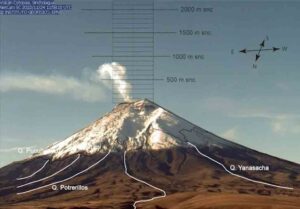The mountain, located in the province of Morona Santiago, began a new eruptive process on May 7, 2019, characterized since then by explosions, gas emissions, ashes and lahars descending through the Volcano and Upano rivers.
On January 16, the Geophysical Institute of the National Polytechnic School confirmed at least two 500-meter high emissions from the crater and the fall of ashes in some communities, affecting the crops and the air quality, forcing residents to wear masks.
According to the Risk Management Secretary, Alexandra Ocles, as a preventive measure against the recent Sangay’s behavior, they have already delivered around 14,000 «volcano kits», with the necessary supplies to pass the eruptive period.
Sangay volcano, one of the most active in this Andean country, is the last one in the south of Ecuador and is located in the Cordillera Real, from where its expulsion of ashes and pyroclastic material affects localities not only in Morona Santiago, but also in nearby provinces such as Chimborazo.
rly/abo/jcm/scm























